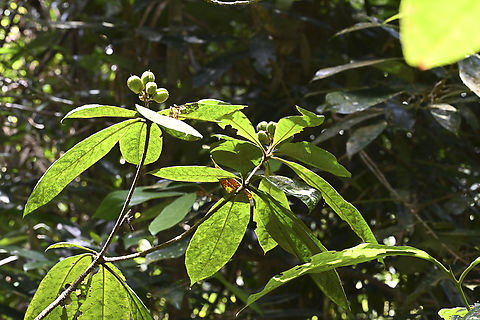
Appearance
"Idiospermum australiense" has, in contrast to its weighty evolutionary significance and its extraordinarily unique fruit, a rather nondescript overall appearance. It is a broadleaf evergreen tree growing to around 25 m tall, with a maximum trunk diameter at breast height of around 60 cm. The leaves are simple, opposite and glabrous. They measure up to 24 cm long by 10 cm wide, with 7−10 pairs of lateral veins. They are held on petioles measuring 10 to 25 mm long, and the leaf blades exhibit numerous 'oil dots' or pellucid glands when held up against a strong light source.It is a relic of the ancient forests of Gondwana, surviving in very localised refugia for 120 million years, and displaying features that are almost identical to fossil records from that time. As such it provides an important insight into the very early evolution of flowering plants.
Naming
The name "Idiospermum" derives from the Ancient Greek words "idios" meaning "individuality" or "peculiarity", and "spérma" meaning "seed", and is a reference to the unique characteristics of the fruits. The common name "idiot fruit" is a mistranslation of this.Distribution
The area occupied by the populations of "Idiospermum australiense" is a total of just 22.5 km2 : 108 There are two main populations, the first, is approximately 50 km south of Cairns, in the vicinity of the Russell River and its tributaries. The other is approximately 120 km north of Cairns and around 10 km south of Cape Tribulation, in the areas of Cooper and Noah Creeks. Both areas are rainforested lowlands at the foot of high, rain-attracting mountains, with annual rainfalls of more than 3,000 mm, and alluvial soils. As the seeds of ribbonwood are only dispersed by gravity, the distribution of the species can only expand seawards.Status
Although this species has a very restricted range and has lost much of its former habitat, the remaining areas in which it occurs are now protected. Accordingly it is listed by the Queensland Department of Environment and Science as least concern. As of 9 April 2023, it has not been assessed by the International Union for Conservation of Nature.Habitat
A large variety of insects, mostly beetles and thrips, are attracted by the scent and colour of the flower, and they in turn attract predators such as spiders and ants. Only the beetles and thrips appear to take a role in pollination, which is completed only when an insect first visits a flower in the male phase and then carries pollen to a flower in the female phase.References:
Some text fragments are auto parsed from Wikipedia.